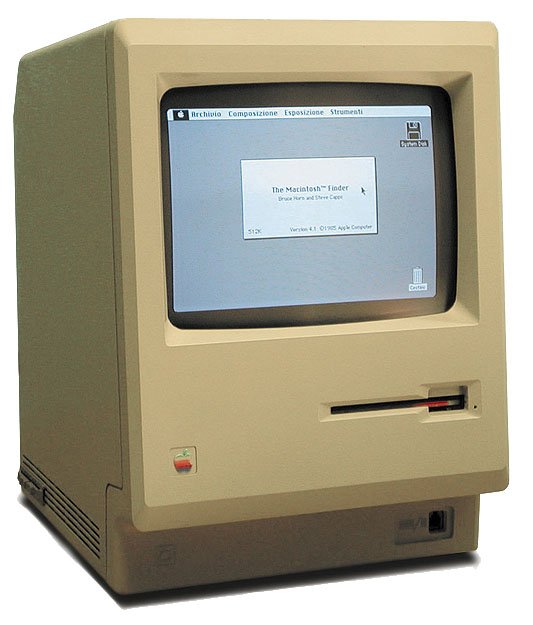Happy Birthday, Macintosh

Thirty years ago today, the Macintosh went on sale for the first time. It was a world-changing moment, though few, if any, recognized it at the time. In fact, the Mac struggled to find its own footing at first, and has struggled at various times during its existence. But the Mac has endured. 2014 finds the Mac a vital and thriving platform, more popular now than ever.
These days we're accustomed to a grand unveiling whenever Apple introduces a new product — it's shrouded in mystery until the final reveal. Back in 1984 things were different. The Mac wasn't a secret at all — the project had been in full swing for several years at Apple, and Apple unveiled the Mac to the press in the fall of 1983, publishing a dozen and a half page brochure in various computing magazines that December. People interested in computers already knew about it.
But on January 22nd, Apple grabbed the attention of the entire country when it advertised the Mac in a 60-second 1984 ad during the Super Bowl, then put the computer on sale two days later.
That first Mac, a beige computer designed to look like a kitchen appliance, is quaint by today's standards: an 8 MHz processor mated to 128 KB of RAM, a single 400 KB floppy drive for storage, a 512 x 342 pixel black and white display. But at the time it was utterly revolutionary.
What separated the Mac from other computers of the era was a graphical interface — you clicked on pictures and menus using a mouse to make things happen. It was intuitive and easy to use even for someone without any previous computer experience. Other computers, even the Apple II, used a command line-driven interface that wouldn't do anything unless you knew what commands to type. It's was so groundbreaking an unusual that the first Mac shipped with software and documentation to explain how to use a mouse and move the cursor around the screen. It was just fundamentally beyond how most people knew computers to work at the time.
The Macintosh democratized the way people used computers: you no longer had to have special skills to operate a computer, to produce beautiful-looking word processing documents or images. Anyone who could wield a mouse and type on a keyboard could do it.
In 1985 Apple introduced networking to the Macintosh. It was another truly disruptive idea — up until then networked computers were largely the domain of big corporations. Using simple-to-install AppleTalk connections, an office of Macs could share a single laser printer — the Apple LaserWriter.
Master your iPhone in minutes
iMore offers spot-on advice and guidance from our team of experts, with decades of Apple device experience to lean on. Learn more with iMore!
This would not only usher in countless offices of networked Macintoshes, but it would also herald a seismic change to the publishing industry. Within a few years, industrial typesetting would be a thing of the past, replaced by desktop publishing.
The Mac ushered in the era of the graphical user interface, a sea change to the way personal computers worked. It would be six years before Microsoft published Windows 3.0, which was finally "good enough" for most PC users to use instead of the MS-DOS command line interface that preceded it. And it would arguably take until Windows 95 before Microsoft finally got its GUI act together.
Much has changed in thirty years of Macintosh evolution: Apple has changed the form and function of the Mac many times, changed its internal operation from Motorola chips to PowerPC and then to Intel. The company developed the PowerBook, the iMac and other machines that that fundamentally alter the way that businesses operate, the way that people work and the way computers are made.
We all have stories about our first experience with the Mac. For many of us, it was a revelatory experience. For some it was our first computer, the only system we've ever known or felt comfortable with. For others, it was the end result of years of frustration with other computer systems. However we've gotten here, it doesn't matter. Our common experience is that the Mac is what empowered us to do more with a computer than we ever thought we could.
The road since the Macintosh was created is littered with the corpses of dead technologies and obsolete systems that have gone by the wayside in favor of new technology. Even some of Apple's products are there, like the Newton platform and the venerable Apple II.
Ultimately it's a testament to the legacy of the Macintosh that 30 years on, it's a vital and thriving platform — one that's still a cornerstone of Apple's business, and a computer that millions of people around the world rely on to get their work done, to communicate with others, and to express their creativity in unique and wonderful ways.
We couldn't have imagined what 2014 would look like when that first Mac hit the scene back in 1984. Something like the Mac Pro — capable of editing movies and rendering 3D graphics in real time while driving three huge high-resolution monitors, all doing it using solid state storage, gigabytes of memory and wireless networking — would have been the stuff of fringe science fiction.
Similarly, it's hard to imagine what the Mac will look like in another 30 years. But I can tell you one thing for sure: As long as there's a Mac, millions of us will still use it.
Happy 30th birthday, Macintosh. I can't wait to see what you'll look like when you turn 60.

